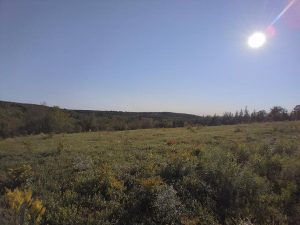Kevin Smith posted these items on Facebook. I asked his permission to post them here. They are credible and concerning observations from the front lines of #StoptheSpray. – dp
Oct 5, 2021:
This is likely the saddest thing I have come across since being out here. The first picture is coyote scat, containing only plastic and grass.
I have, for some time, made it a habit to check predator droppings, as it’s a good indicater of what is in and/or going on in the area. I’ve come across dozens of findings from coyotes since I’ve been here. Most are a mixture of seeds, roots, and berries. But NONE, have contained more than a trace amount of fur, likely their own.
This particular coyote ate plastic because it couldn’t find anything else but grass to eat. This is likely due to the fact that its habitat is disappearing before my eyes.
What isn’t clearcut here by the landowner, is turned into cultivated wild blueberry fields. While blueberries are an excellent food source for animals one month out of the year, for the other 11 months it is an unnatural waste land containing nothing but low cut berry bushes. There is nothing more sublime than looking out at these vast plains in the middle of forests.
Once a clear cut is sprayed, it too becomes an unnatural waste land. There are no acorns for squirrels and chipmunks to eat. No hard wood saplings or birch bark for deer to survive on during harsh winters. There is also no leafy greens for rabbits, no amphibians or insects to attract wild birds. There is only a spruce plantation, standing where an ecosystem used to be and nothing left but plastic for the coyotes to scavange.
This province’s forests are on the brink of ecological break down. I see the signs myself here everyday, and hear countless stories from aged hunters about “how it used to be,” and the diminishing game and grounds to hunt on. Some have even mentioned the bugs, and how they aren’t as bad anymore. I don’t have the heart to tell them, how serious that is for all of us…
*Note: I have ambivalent feelings towards coyotes here as they are not native to this province and have only been here since the 1970s (after Settlers killed off the wolf population) but this was just too freaking much.
———–

TOP: Left over stumps from clear cut of 1986. About 18 inches in diameter. BOTTOM: Stumps from recent clear cut measure about 6 inches in diameter. Many are much smaller.
Oct 3, 2021:
Day 21: This spray site was clear-cut in 1986, and again just a few years ago. Many of the old stumps from 86 remain, they have yet to rot away before the forest was cut again. The average size of the stumps left over from 35 years ago were about a foot and a half in diameter. The average stumps left this time are about 6 inches, with many much smaller. Rotting birch trees that were cast aside whole litter the area along with mass amounts of “waste” and “brush” material.
Where I camp at night is also in a clear cut, one that is ripe to be clear cut again. The earth is still scarred from the tank tracks of the heavy machinery that cleared the land around 30 years ago. My fire pit sits within a deep tread mark. There is nothing “natural” left about it, and it will only be scarred and cleared yet again, before it can heal itself properly.
Comment on WWNS
GF: Its not uncommon for predators to eat grass. It’s a main stable of bears in the spring. Even dogs will eat it regular . Coyotes do not waste energy chasing food sources when other food sources are aviable . Coyotes have a very keen sense of smell . The plastic likeky was a food wrapper of some type. The Coyotes normal range is about 20 km , but one we tracked went 90 km . It traveled from the cape brenton highlands park to the Port hawksbury paper mill so a few road ditches are on there route . We did tracking of Coyotes and Coyotes often use roads as territorial boundaries between family groups. Often mowing blueberry fields in the fall , Coyotes will follow the mower picking up mice disturbed by the mowing process. It’s also common for hawks to do as well.
.


